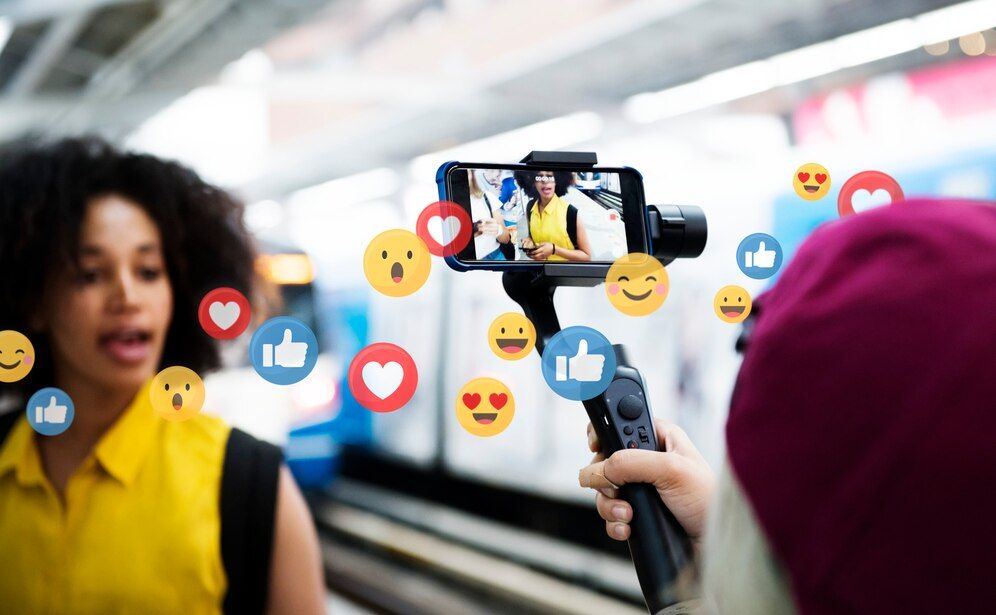BLOG
Leveraging Influencers for Marketing Success

In today's digital age, leveraging influencers has become an indispensable strategy for brands striving for marketing success. The power of influencers lies in their ability to authentically connect with audiences, cultivating trust and credibility that traditional advertising often struggles to achieve.
By partnering with influencers whose values align with their own, brands can tap into established communities and gain access to niche markets with unparalleled effectiveness. Furthermore, influencers bring a dynamic edge to marketing campaigns, infusing them with creativity and relatability that resonates deeply with today's consumers.
From social media personalities to industry experts, influencers wield significant sway over purchasing decisions, making them invaluable assets for brands seeking to expand their reach and drive engagement. In this blog, we'll delve into the myriad ways in which brands can harness the potential of influencers to propel their marketing efforts to new heights.
Understanding the Influencer Landscape: Identifying Key Players
In the dynamic world of influencer marketing, success hinges on a deep understanding of the influencer landscape. It's crucial to identify key players who hold sway over your target audience.
This involves meticulous research to pinpoint influencers who align with your brand's values, aesthetics, and target demographic. Analyzing factors like engagement rates, audience demographics, and content quality can help discern the most influential voices in your industry or niche.
By identifying these key players, brands can forge meaningful partnerships that yield tangible results. Moreover, understanding the nuances of various social media platforms and emerging trends is essential for navigating the ever-evolving influencer landscape effectively.
Crafting Authentic Partnerships: Finding the Right Fit for Your Brand
Authenticity lies at the heart of successful influencer partnerships. Crafting genuine collaborations requires more than just selecting influencers with large followings; it's about finding individuals whose values, interests, and audience align closely with your brand.
A shared ethos fosters credibility and trust, enhancing the effectiveness of marketing campaigns. Brands should prioritize authenticity over reach, seeking influencers who can authentically integrate products or services into their content. Moreover, fostering open communication and collaboration ensures that partnerships remain true to both the influencer's style and the brand's objectives.
By prioritizing authenticity and synergy, brands can cultivate long-lasting partnerships that resonate with consumers on a deeper level, driving engagement and loyalty.
Defining Goals and Objectives: Setting Clear Expectations
Defining goals and objectives is crucial in influencer marketing for aligning brand vision and campaign outcomes. Here's what to consider:
- Specificity: Define clear objectives like increasing brand awareness or driving sales.
- Measurability: Identify key metrics for tracking campaign success.
- Realistic goals: Ensure objectives are achievable within resources and timeframes.
- Alignment: Goals should align with overall marketing strategy and business objectives.
- Flexibility: Stay adaptable to changes in market dynamics and audience preferences.
Clear goals and objectives lay the foundation for successful influencer campaigns, driving tangible results and maximizing ROI.
Navigating Legal and Ethical Considerations in Influencer Marketing
In the rapidly evolving landscape of influencer marketing, navigating legal and ethical considerations is paramount. With increased scrutiny from regulators and consumers alike, brands must ensure transparency and compliance in all influencer partnerships.
Understanding and adhering to relevant regulations, such as disclosure requirements for sponsored content, helps maintain credibility and trust with audiences. Additionally, brands should establish clear guidelines and contracts outlining expectations, usage rights, and compensation to protect both parties' interests. Prioritizing ethical practices, such as honesty, authenticity, and respect for audience privacy, fosters long-term relationships and safeguards brand reputation.
By proactively addressing legal and ethical considerations, brands can mitigate risks and build a foundation of trust with consumers in the influencer marketing landscape.
Maximizing Reach: Strategies for Amplifying Influencer Content
Maximizing the reach of influencer content is crucial for ensuring its effectiveness in reaching and engaging target audiences. Here are some strategies to amplify influencer content and extend its reach:
- Cross-Promotion: Collaborate with influencers to share content across their social media platforms, as well as your brand's channels, to reach a wider audience.
- Paid Promotion: Invest in paid advertising to boost the visibility of influencer-generated content, reaching audiences beyond organic reach.
- Content Syndication: Syndicate influencer content on relevant websites, blogs, and media outlets to increase exposure and drive traffic back to your brand.
- Influencer Networks: Partner with influencer networks or platforms to access a diverse pool of influencers and amplify content across multiple channels.
- User-Generated Content: Encourage your audience to create and share content featuring your products or services, leveraging their networks to amplify your brand message.
By implementing these strategies, brands can amplify influencer content and maximize its reach, ultimately driving greater engagement and achieving marketing objectives.
Measuring Impact: Evaluating ROI and Effectiveness
Measuring the impact of influencer marketing campaigns is crucial for determining their effectiveness and ROI. Tracking metrics such as engagement rates, click-through rates, conversion rates, and brand sentiment provides valuable insights into the success of influencer partnerships. By continuously monitoring performance data and conducting post-campaign analysis, brands can refine their strategies and maximize results.
- Engagement Rates: Measure the level of interaction and engagement generated by influencer content.
- Click-Through Rates: Track the percentage of users who clicked on a link included in influencer content.
- Conversion Rates: Evaluate the rate at which influencer-generated leads or traffic convert into customers or sales.
- Brand Sentiment: Assess audience perception and sentiment towards the brand following influencer collaborations.
- Post-Campaign Analysis: Conduct surveys or sentiment analysis to gather feedback and insights from the audience regarding the influencer campaign's impact.
Effective measurement is key to evaluating the success of influencer marketing campaigns and optimizing future strategies. By utilizing quantitative metrics and qualitative analysis, brands can accurately assess ROI and effectiveness, refining their approaches for maximum impact.
Building Long-Term Relationships: Fostering Loyalty with Influencers
While one-off influencer campaigns can yield short-term results, building long-term relationships fosters loyalty and delivers sustained value. Investing in ongoing partnerships with influencers cultivates trust, familiarity, and authenticity, which resonate more deeply with audiences over time.
By nurturing these relationships, brands gain access to a dedicated advocate who understands their brand ethos and effectively communicates their messaging. Collaborating on multiple campaigns allows influencers to develop a deeper understanding of the brand's products, services, and target audience, resulting in more authentic and impactful content.
Moreover, rewarding loyalty through exclusive perks, incentives, and co-creation opportunities incentivizes influencers to remain committed and invested in the brand's success. By prioritizing long-term relationships over short-term gains, brands can unlock the full potential of influencer marketing, driving sustained growth and engagement.
Harnessing the Power of Micro-Influencers: Targeting Niche Audiences
While macro-influencers boast large followings, micro-influencers offer unique advantages when targeting niche audiences. With smaller but highly engaged follower bases, micro-influencers possess a more intimate connection with their audience, resulting in higher levels of trust and authenticity. Collaborating with micro-influencers allows brands to access hyper-targeted communities and niche markets that may be overlooked by larger influencers.
Moreover, micro-influencers often offer higher engagement rates and lower costs per engagement, making them a cost-effective option for brands with limited budgets. Leveraging the power of micro-influencers enables brands to deliver personalized and relevant content that resonates deeply with specific audience segments.
By identifying and partnering with micro-influencers who align with their brand values and target demographics, brands can effectively reach and engage niche audiences, driving meaningful results and fostering brand advocacy.
Integrating Influencer Campaigns with Overall Marketing Strategies
Successful influencer marketing isn't conducted in isolation; it's seamlessly integrated with overarching marketing strategies. Aligning influencer campaigns with broader marketing initiatives ensures consistency in messaging and amplifies brand visibility across channels.
By incorporating influencer-generated content into larger marketing campaigns, brands can extend their reach and reinforce key brand messages. Moreover, integrating influencer partnerships with other marketing channels, such as social media, email marketing, and content marketing, creates a cohesive brand experience for consumers.
Collaborating closely with internal marketing teams and agencies facilitates coordination and alignment between influencer activities and overarching marketing objectives. By treating influencer marketing as an integral component of the marketing mix, brands can maximize its impact and leverage influencers to achieve broader business goals.
Adapting to Emerging Trends: Staying Ahead in the Evolving Influencer Landscape
The influencer landscape is constantly evolving, driven by shifts in consumer behavior, technological advancements, and emerging platforms. To stay ahead in this dynamic landscape, brands must remain agile and adaptable, continually monitoring and adapting to emerging trends. This involves staying abreast of new social media platforms, content formats, and influencer trends that resonate with evolving consumer preferences.
Experimenting with innovative approaches, such as live streaming, interactive content, and augmented reality experiences, allows brands to differentiate themselves and capture audience attention in crowded digital spaces. Moreover, fostering a culture of experimentation and learning enables brands to test and iterate their influencer strategies to stay ahead of the curve.
By embracing change and proactively adapting to emerging trends, brands can maintain relevance, engage audiences effectively, and drive sustained success in the ever-evolving influencer landscape.
Navigating the complex landscape of influencer marketing requires a strategic approach and a deep understanding of industry dynamics. By leveraging the insights and strategies outlined in this guide, brands can harness the power of influencers to drive meaningful results and gain a competitive edge.
From identifying key players to fostering long-term relationships and adapting to emerging trends, each aspect plays a crucial role in maximizing the impact of influencer marketing efforts. As you embark on your influencer marketing journey, remember to prioritize authenticity, set clear goals, and stay agile in response to evolving consumer behaviors and platform trends. With our proven Social Cali Manteca Marketing Strategies, you can confidently navigate the influencer landscape and position your brand for success.
Contact us today at 1-415-888-9561 or email sales@socialcali.com to learn how we can help you dominate the competition and achieve your marketing objectives. Experience firsthand how Social Cali can empower your brand to thrive in the dynamic world of influencer marketing.











